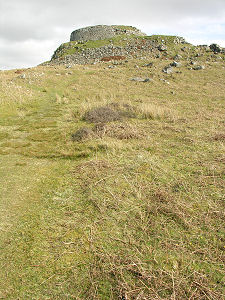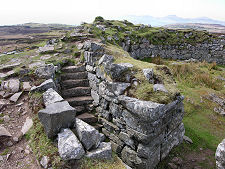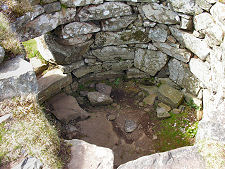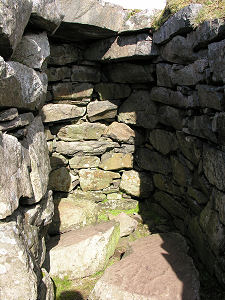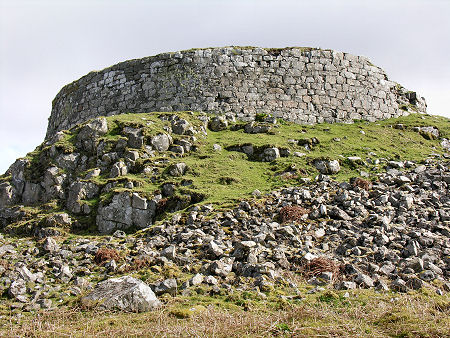 The Exterior of Dun Beag Broch |
At Bracadale, on the west coast of the Isle of Skye, the main road north to Dunvegan skirts around the head of Loch Beag before climbing a hillside that gives increasingly good views west over Loch Bracadale. A little before the road reaches its highest point there is a car park on its western side. A gate on the opposite side of the road gives access to a grassy track that leads steeply uphill to an obvious stone structure on a rocky outcrop. This is Dun Beag, or "little fort".
Dun Beag is a broch, one of around five hundred to be found across mainly the north and west of Scotland. Brochs were built in the last centuries BC and the first centuries AD and were circular in plan, rising to a height of 13 metres or more: this is the height of the best preserved example, Mousa Broch in the Shetland Islands. Opinions differ as to their purpose. Some view them as primarily defensive structures, while others believe they were symbols of prestige and power, intended to demonstrate the wealth of the local chieftain and his ability to harness the manpower and resources necessary to build such a highly visible structure.
Dun Beag does little to help resolve this debate one way or the other. Its location certainly dominates the landscape to its western, coastal side, and the use it makes of the sheer face of the rocky outcrop to its north suggests a strong defensive position. On the other hand the landscape to its east rises steadily and does not give the same sense of impregnability.
The truth is that these structures were probably multi-purpose, designed for day to day habitation as well, when necessary, as defence. And when you look at the location of Dun Beag on the map, you could even make a case for its design as a landmark for early sailors seeking to find a way from Loch Bracadale into the fjord-like Loch Harport. The presence of another broch, Dun Ardtreck, on the south side of the entrance to Loch Harport could support this theory, though in fairness, this broch could also have been primarily defensive in nature.
Anyone intending to explore Dun Beag should be aware that the climb to it and the tops of the walls are grassy and steep in places: and that there are significant drops from the wall tops, especially on the northern side. Good footwear is strongly recommended, especially if the ground is wet. Having climbed the slopes to its west, you approach Dun Beag, as its builders would have done, from the south-east side. What you find is a structure which is remarkably well preserved up to about 1.5 metres in height. The exterior stonework is especially impressive in places, though it is difficult to know how much of this is original and how much the work of amateur excavators in the years to 1920.
The interior of the broch is abut 11m in diameter, within stone walls that are some 4.3m thick on average. As with other brochs, it is clear that the walls were built as outer and inner skins, with gaps and cavities left between them to lighten and (probably) help insulate and ventilate the structure. The gaps between the walls also left space for stone stairs: those at Dun Beag are especially impressive.
When originally built Dun Beag would have been 10m or more taller than it is today. The residents would have lived at first floor level and above, while the ground floor would have been used for keeping livestock. The whole structure would have been roofed over with wood and thatch and there may have been a defensive rampart around the top.
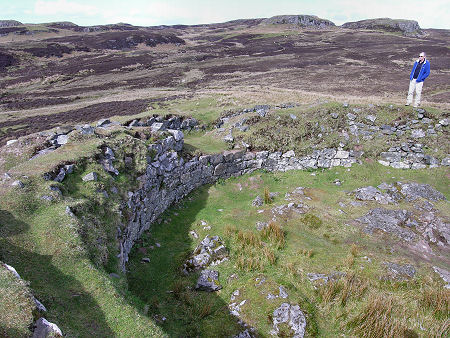 Interior of the Broch from the Top of the Wall |
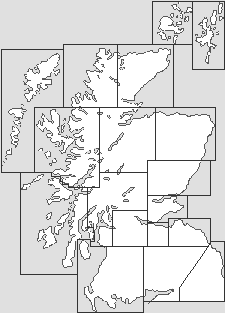
|
|
|
Visitor InformationView Location on MapGrid Ref: NG 339 386 www.historicenvironment.scot HES: Broch Web Page Open all year and admission is free. What3Words Location: ///chefs.chromatic.publish |
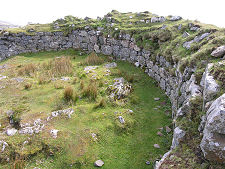 The Inside Face of the Wall |
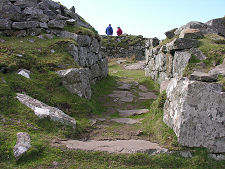 The Entrance to the Broch |
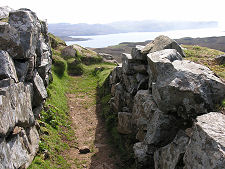 Space Within the Exterior Walls |
 Stone Steps |

